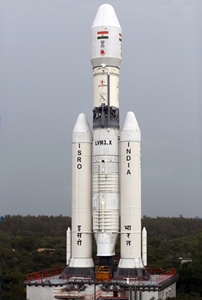Isro tests lunar crew module on its heaviest rocket GSLV-Mark III
18 Dec 2014
The Indian Space Research Organisation (Isro) today successfully launched its heaviest rocket GSLV-Mk III on Thursday at 9:30 am from Sriharikota in Andhra Pradesh, marking a significant day for India's space programme.
 | |
| GSLV Mk-III integrated with CARE being transported to Second Launch Pad |
The 630-tonne 42.4 metre tall three-stage rocket blasted off with an experimental crew module that separated from the launch vehicle after reaching a sub-orbital height of around 120km and then splashed into the Andaman Sea. Naval ships waiting for the splashdown later picked up the crew module.
Isro would study the flight validation of the complex atmospheric flight regime of the crew module, called LVM 3. The experiment will validate the module's ability to re-enter the earth's atmosphere with thermal resistance, parachute deployment in cluster formation, aero braking system and apex cover separation procedures.
The crew module separated from the rocket as planned and made a 'soft-crash' into the Bay of Bengal some few hundred kilometres from Indira Point in the Andaman and Nicobar Islands with the help of parachutes, which was picked up by Indian Coast Guard ships.
GSLV-Mk III is conceived and designed to make India fully self reliant in launching heavier communication satellites of INSAT-4 class, which weigh 4,500 to 5,000 kg. It would also enhance the capability of the country to be a competitive player in the multimillion dollar commercial launch market.
While the rocket cost Isro Rs140 crore, the crew module has taken another Rs15 crore.
The crew module, shaped like a giant-size cup cake - black in colour on top and brown at the bottom - weighs around four tonnes. It is about the size of a small bedroom and can accommodate two - three people.
Isro had earlier carried out a similar experiment on a smaller scale in which the module had orbited around the earth for 15 days before entering back and the current experimental flight of the LMV 3 is a further validation of Isro's human space mission capabilities.
Isro chief Dr K Radhjakrishnan confirmed the successful launch of GSLV-Mk III, terming it a very significant day for India. The Isro chief congratulated his team on the highly successful launch.
''Isro has successfully carried out human crew module experiment. The module has safely splashed down into Bay of Bengal off Andaman and Nicobar Islands,'' said Radhakrishnan.
"GSLV-Mark III test flight mission successful. It is a significant day in India's space history," Radhakrishnan said after the launch.
Prime Minister Narendra Modi congratulated Isro for the successful launch of GSLV Mk-III. "Successful launch of GSLV-Mk III is yet another triumph of brilliance and hardwork of our scientists," the Prime Minister tweeted.
GSLV-Mk III was launched using a dummy engine as Isro is still in the process of developing the cryogenic engine capable of carrying heavier payloads up to four tonnes, which is expected to be ready within two years, Radhakrishnan said.
He said the cryogenic engine was being developed at the Liquid Propulsion Systems Centre at Mahendragiri in Tirunelveli district of Tamil Nadu. The GSLV-Mk III was on Thursday launched with active S200 and L110 propulsive stages and a passive cryogenic stage (C25) with dummy engine.
Isro, meanwhile, is gearing up for the launch of another Indian Regional Navigational Satellites System (IRNSS), the fourth in the series of seven satellites of the IRNSS, in the first week of March next year.
With the completion of the system, India would join a select group of countries having their own navigation systems.
This comes less than three months after Isro successfully launched Mangalyaan – a spacecraft orbiting Mars – catapulting India to the elite club of nations that have successfully sent missions to the red planet (See: MOM Mangalyaan sends pics of Martian dust storm).







.webp)














